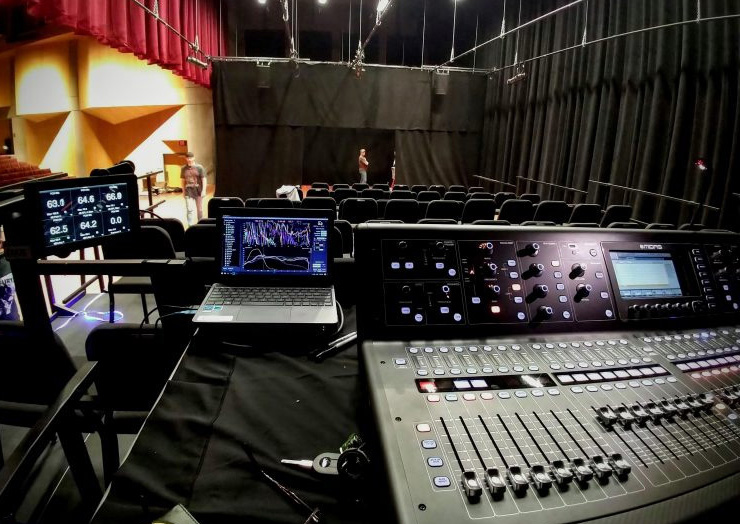
Surround Center
This box comes reasonably close to the flown L/R, and note the clear effect of reflections on the phase trace between 1 and 2 kHz (Figure 7). I’ll revisit this in a bit.

Deck L/R
The lighting crew was building booms while I had to verify this system, so I moved both boxes into the same location side by side, set the measurement mic on the floor about 15 feet away, and compared their responses (Figure 8).

The slight phase deviation up top is because I didn’t bother resetting the analyzer’s delay when I switched boxes, and of course they are not exactly in the same spot. Just for fun, we can note that the two traces reach 180 degrees offset at about 6.3 kHz, or a time offset of 0.08 milliseconds (ms), or a distance of about an inch. They’re not in their final position so I’m going to hold off on EQ for the moment.
Subwoofers
These are a pair of the new QSC KS118s and they’re awesome. They’re stuffed up under the middle of the rearmost seating riser (the only one tall enough to fit them underneath). I’m running them in Deep mode for extended LF response, with the XO set to 100 Hz for the time being. Since they’re an independent effects channel, there’s no spatial crossover to “align.”
Leveling
Now that everything is behaving, I placed the measurement mic dead center in the audience area and set the levels to something approaching reasonable. For this I use relatively high levels of smoothing because the general trend of the vertical offset is the main thing I’m paying attention to at this point.
Figure 9 depicts the main L/R along with the rear L/R surrounds. The HF rolloff from those is evident as they’re firing through thick drape, but we are matched well from MF on down. Any further EQ on this will be dictated by the wishes of the designer upon arrival.

Figure 10 shows what happens when the center surround box (purple) is added. And here we have an interesting choice to make. The box has a tonal response matching the flown surrounds, but it is currently level-matched to the mains in the HF.

Our options are:
A) Shelf down the LF so it matches the mains in the HF, and the entire rig in the LF. I would choose this option if it’s to be operated as an independent center channel.
B) Attenuate it by approximately 8 dB so it matches the flown L-R surround on either side in both level and tone. This is the option I would choose if the three are to be operated as a L-C-R soundscape.
I ended up choosing the first option to start, and make a note to ask the designer if a different approach is desired. In Figure 11, we see that box’s response in purple with the 1/EQ in bright green – simply a -4 dB low shelf up to 1 kHz.

In the event that the designer chooses to have flown C match flown L/R, I can simply bypass the EQ and lower the gain by 8 dB to match the response of the side boxes. I don’t yet know the final placement of the deck side fills but they’re a dual 12-inch box aimed off axis to the audience and placed against a stage floor, so the LF buildup is much more than all the other boxes in the system (Figure 12).

Again, this is a decision for the designer, but to start I used a slight LF shelf to tame it just a bit and bring them closer to uniformity. Figure 13 shows the deck fill responses before and after the shelving EQ, with the inverted EQ response shown in green.

The end result (Figure 14) is that when a signal is panned between the loudspeakers, the level should stay relatively consistent. The major choice to be made by the designer at this stage is whether the upstage center box should match the mains – as it does currently – or be rolled off at HF to match the upstage L/R.

